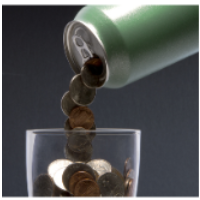California’s Sugar High Costs It Hundreds of Millions for Healthcare

On the heels of a study showing an alarming spike in the consumption of sugary sodas by California adolescents, a new study shows the state could save $100 million on healthcare costs annually if it taxed the drinks an extra penny per ounce.
Researchers at the University of California, San Francisco calculated that such a tax would reduce diabetes and heart disease 10-20% and be especially beneficial to African-Americans, Mexican-Americans and people with limited income. Sugar-sweetened beverages (SSB) are also blamed for increases in obesity, hypertension and liver dysfunction.
African-Americans get 9% of their caloric intake from SSBs and Mexican-Americans get 8%, compared to 5% for whites, according to the National Health and Nutrition Examination Survey (NHANES).
The tax would add 12 cents to a can of soda and 67 cents for a two-liter bottle. Legislation to do just that was introduced last year by state Senator Bill Monning (D-Carmel), but it never got out of committee. An analysis of the bill by the Senate Appropriations Committee projected state revenue gains of $1.8 billion in 2014-15.
The author plans on reintroducing the legislation this year. State soda taxes were proposed in 1983, 2002 and 2010 and all failed in the Legislature. Ballot measures to tax sodas in the cities of El Monte and Richmond failed in 2012.
More than 10 million Californians help themselves to a soda every day and an industry estimate cited by the legislative analyst indicates they consume about 174 billion ounces of sweetened beverages a year. After doing some math, the analyst determined that that worked out to about 41 gallons per person and cautioned that the numbers and projected tax revenues may be too high.
Adults are the most sensible soda consumers, with 24% drinking one or more sodas a day. Forty-one percent of children between 2-11 do the same, but the real guzzlers are adolescents, 62% of whom imbibe on a regular basis. A study by the California Health Interview Survey in October found an 8% spike in adolescent soda consumption over the past seven years that was hardly tempered by findings that children 2-5 had reduced their sugary intakes 30% during the same period.
The UC San Francisco study projected that a 10-20% reduction in SSB from the penny-per-ounce tax would lower the incidence of diabetes by 12,000 to 23,000 cases. If the state got wild and crazy and instituted policies that reduced SSB intake 50%, diabetes would be reduced 8% and save 53,000 people a lot of pain and expense over a decade.
–Ken Broder
To Learn More:
Study Shows Soda Tax Would Save Millions in Health Care Costs (by Jason Hoppin, Santa Cruz Sentinel)
Health Benefits of Reducing Sugar-Sweetened Beverage Intake in High Risk Populations of California: Results from the Cardiovascular Disease (CVD) Policy Model (UC San Francisco)
New Study Finds Spike in Sugary Drink Consumption among California Adolescents (by Gwen Driscoll, UCLA Newsroom)
Soda Tax Health Benefits Would Help Minorities the Most (by Ken Broder, AllGov California)
- Top Stories
- Controversies
- Where is the Money Going?
- California and the Nation
- Appointments and Resignations
- Unusual News
- Latest News
- California Forbids U.S. Immigration Agents from Pretending to be Police
- California Lawmakers Urged to Strip “Self-Dealing” Tax Board of Its Duties
- Big Oil’s Grip on California
- Santa Cruz Police See Homeland Security Betrayal in Use of Gang Roundup as Cover for Immigration Raid
- Oil Companies Face Deadline to Stop Polluting California Groundwater





